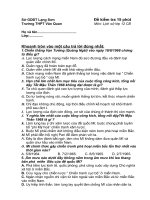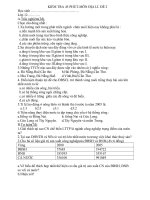Unit 2 lớp 12: Cultural Diversity-Reading
Bạn đang xem bản rút gọn của tài liệu. Xem và tải ngay bản đầy đủ của tài liệu tại đây (672.64 KB, 6 trang )
<span class='text_page_counter'>(1)</span><div class='page_container' data-page=1>
eLib.vn: Thư viện trực tuyến miễn phí 1
UNIT 2: CULTURAL DIVERSITY – READING
1. Before You Read Unit 2 lớp 12
Work in pairs. Discuss the question: Which of the following factors is the most
important for a happy life? Why? (Làm việc theo cặp. Thảo luận câu hỏi: Yếu tố nào dưới
đây được cho là quan trọng nhất với một cuộc sống hạnh phúc? Tại sao?)
Love Money Parents’ approval
A nice house/flat A good job Good health
Guide to answer
A: For a happy life, I think all the following factors are necessary but the most important is
love and health. Do you think so? (Để có một cuộc sống hạnh phúc, tôi nghĩ rằng những nhân
tố sau đều rất cần thiết nhưng quan trọng nhất vẫn là tình u và sức khỏe. Bạn có nghĩ vậy
khơng?)
B: Oh, why don’t you think another factor such as: money or a good job? (Ồ, vậy tại sao bạn
không nghĩ tới các yếu tố khác, chẳng hạn như tiền hay một công việc tốt?)
A: As you know, love, especially the true love, is an essential factor for a marriage life.
Someone compares love with light or water to life. Indeed, with love we can suffer the
hardship, sufferings or misfortunes of life. And there’s an important aspect of love:
forgiveness. We can say love and forgiveness are two inseparable qualities. (Như bạn biết
đó, tình u, đặc biệt là một tình u đích thực, là một yếu tố quan trọng trong cuộc sống hôn
nhân. Một số người so sánh tình yêu với ánh sáng hay nước của sự sống. Thật vậy, vì tình
yêu chúng ta có thể chịu đựng những khó khăn, đau khổ hay bất hạnh của cuộc đời. Và có
một khía cạnh quan trọng của tình u: sự tha thứ. Có thể nói tình u và sự tha thứ không
thể tách rời nhau.)
B: Yeah, alright. What about good health? Is it indispensable, too? (Vâng, đúng vây. Thế cịn
sức khỏe tốt thì sao? Nó cũng cần thiết vậy phải không?)
A: Sure. I believe that we can’t do anything for your life if you have ill health. (Đương nhiên
rồi. Tôi tin rằng chúng ta không thể làm bất kì điều gì cho cuộc sống này nếu bạn có một sức
khỏe yếu ớt.)
B: Ok, totally agree with you. (Tơi hồn tồn đồng ý với bạn.)
2. While You Read Unit 2 lớp 12
Read the passage and do the tasks that follow. (Đọc bài khóa và thực hiện những nhiệm
vụ kèm theo)
Bài đọc có thể tóm tắt theo 3 phần như sau:
Phần đầu: (Traditionally, … not precede it.) Đưa ra quan điểm của người châu Mỹ và
người châu Á về hơn nhân và tình u.
Phần thứ 2: (To show …. because he has to): 4 yếu tố then chốt cho sự khác biệt văn
hóa thông qua bài khảo sát từ sinh viên châu Mỹ, Trung Quốc và Ấn Độ.
</div>
<span class='text_page_counter'>(2)</span><div class='page_container' data-page=2>
eLib.vn: Thư viện trực tuyến miễn phí 2
2.1. Task 1 Unit 2 lớp 12
Explain the meaning of the italicized words/phrases in the following sentences. (Giải
thích ý nghĩa của những từ hoặc cụm từ in nghiêng trong những câu dưới đây.)
1. Love is supposed to follow marriage, not precede it (Tình yêu được nảy sinh trong hôn
nhân chứ không tồn tại trước đó)
2. A survey was made to determine their attitudes toward love and marriage. (Một cuộc khảo
sát đã được thực hiện để xác định thái độ của họ về tình u và hơn nhân)
3. They agree that it is unwise to confide in their wives. (Họ đồng ý rằng thật không khôn
ngoan khi tin tưởng vào vợ của mình)
4. An Indian woman has to sacrifice more in a marriage than a man. (Trong hôn nhân, người
phụ nữ Ấn Độ phải hi sinh nhiều hơn người đàn ông)
5. A husband is obliged to tell his wife where he has been (Người đàn ơng bắt buộc phải nói
cho vợ anh ta biết nơi anh ta đã đến)
Guide to answer
1. Precede: happen or exist before (đã tồn tại hoặc xảy ra trước đó)
2. Determine: find out (xác định)
3. Confide in: tell someone about something very private or secret (tin tưởng)
4. Sacrifice: willingly stop having something you want (hy sinh)
5. Obliged: having a duty to do something (bắt buộc)
2.2. Task 2 Unit 2 lớp 12
Answer the following questions (Trả lời những câu hỏi dưới đây)
1. What are the key values in the survey? (Theo bài khảo sát có những yếu tố then chốt
nào?)
2. Who are much more concerned with physical attractiveness when choosing a wife or a
husband, the young Americans or the young Asians? (Ai quan tâm đến ngoại hình khi chọn
vợ hoặc chồng, là giới trẻ châu Mỹ hay châu Á?)
3. What are the Indian student’s attitudes on a partnership of equals? (Thái độ của sinh viên
Ấn Độ ở khía cạnh bình đẳng là gì?)
4. Why does the American wife trust her husband to do the right thing? (Tại sao người vợ
châu Mỹ tin chồng mình ln làm những điều đúng đắn?)
5. What is the main finding of the survey? (Ý chính đưa ra trong cuộc khảo sát là gì?)
Guide to answer
1. They are “physical attractiveness, confiding, partnership of equals and trust built on love”.
(Đó là "niềm tin xây dựng trên tình yêu, sức hấp dẫn về thể chất, sự tin tưởng và đối tác
công bằng.")
</div>
<span class='text_page_counter'>(3)</span><div class='page_container' data-page=3>
eLib.vn: Thư viện trực tuyến miễn phí 3
3. The Indian students agree that a woman has to sacrifice more in a marriage than a man.
(Các sinh viên Ấn Độ đồng ý rằng một người phụ nữ đã hi sinh nhiều hơn trong hô nhân
hơn là một người chồng)
4. The American wife trusts her husband to do the right thing because he loves her not
because he has to. (Người vợ Mỹ tin tưởng vào chồng mình làm điều đúng vì anh ấy u cơ
ấy khơng phải vì anh ta bị bắt buộc phải làm điều đó.)
5. The main finding of the survey is young Asians are not as romantic as their American
counterparts. (Phát hiện chính của cuộc khảo sát này là những người châu Á trẻ tuổi không
lãng mạn như những người Mỹ.)
3. After You Read Unit 2 lớp 12
Work in group. Discuss the question: What are the differences between a traditional
Vietnamese family and a modern Vietnamese family? (Làm việc theo nhóm. Thảo luận
câu hỏi: Có những sự khác biệt nào giữa gia đình truyền thống và hiện đại ở Việt Nam?)
Guide to answer
A. I see the traditional Vietnamese family as well as family life is changing a lot. A modern
Vietnamese family is quite different from the traditional one.
B. That’s right. First of all, I think that it's the family size. A traditional family was usually an
extended family; it means that there are more than one generation living together under one
roof.
C. But now a modern family is usually a nuclear family, consisting of only parents and their
children.
D. OK. And we should mention about the number of children. A traditional family was usually
a large one, with more than three. In some families, people could find the number of children
up to ten or even more. However, a modem family, especially families in big cities, has only
one or two children.
A. Next, in a traditional family, the father takes all responsibilities for the family. In other
words, father works and earns money to support the whole family. The woman’s tasks are
confined within the family: bearing children and doing all the housework.
B. Now in a modem family, both husband and wife have to work to support the family.
C. And what’s more husband and wife should share household work together.
D. That's the interesting idea about the modern family: everyone in a family has their own
responsibility to do, that is they should take part in the maintenance or the building of the
family's happiness.
A. OK. The husband and the wife must have the partnership of equals in the family: no one
is superior to the other.
Bài dịch phần Reading Unit 2 lớp 12
</div>
<span class='text_page_counter'>(4)</span><div class='page_container' data-page=4>
eLib.vn: Thư viện trực tuyến miễn phí 4
Để chứng tỏ những sự khác biệt một cuộc khảo sát được tiến hành giữa các sinh viên Mĩ,
Trung Quốc và Ấn Độ để xác định thái độ của họ đối với tình u và hơn nhân. Sau đấy là
bản tóm tắt các câu hỏi của mỗi nhóm cho bốn ý tưởng quan trọng.
Sự hấp dẫn ở ngoại hình: Sinh viên Mĩ quan tâm nhiều về ngoại hình hơn sinh viên Ấn Độ
và Trung Quốc khi họ chọn vợ hay chồng. Họ cũng đồng ý rằng người vợ nên giữ vẻ đẹp và
ngoại hình của mình sau hơn nhân.
Chia sẻ: Ít sinh viên Á châu đồng ý quan điểm của sinh viên Mĩ là vợ chồng nên chia sẻ mọi
ý nghĩ với nhau. Thực vậy, đa số sinh viên Ấn Độ và Trung Quốc thực sự nghĩ rằng sẽ tốt
và khôn ngoan hơn khi vợ chồng không chia sẻ nhiều suy nghĩ chung với nhau. Đặc biệt rất
nhiều người Ấn đồng ý rằng giãi bày tâm sự với vợ là không khôn ngoan.
Mối quan hệ bình đẳng: Đa số sinh viên Á châu bác bỏ quan điểm của người Mĩ hôn nhân là
là mối quan hệ bình đẳng. Đa số sinh viên Ấn Độ đồng ý rằng trong hôn nhân đàn bà phải hi
sinh nhiều hơn đàn ơng.
Tín nhiệm xây dựng trên tình yêu: Đáng chú ý hơn, so với sinh viên châu Mỹ, nhiều sinh viên
châu Á đồng ý rằng người chồng bắt buộc nói cho vợ nơi anh ta đã đi nếu anh về nhà muộn.
Người vợ Á châu có thể yêu cầu báo cáo những hoạt động của chồng. Người vợ Mĩ, chẳng
hạn, tin tưởng chồng mình làm điều đúng vì anh u cơ chứ khơng vì anh bắt buộc phải làm.
Sự so sánh bốn yếu tố then chốt cho thấy giới trẻ châu Á không lãng mạn bằng người Mĩ
đồng trang lứa.
4. Practice
Read the passage carefully and then choose the correct answers These days, most people
in Britain and the US do not wear very formal clothes. But sometimes it is important to wear
the right thing. Many British people don't think about clothes very much. They just like to be
comfortable. When they go out to enjoy themselves, they can wear almost anything. At
theatres, cinemas and concerts you can put on what you like from elegant suits and dresses
to jeans and sweaters. Anything goes, as long as you look clean and tidy. But in Britain, as
well as the US, men in offices usually wear suits and ties, and women wear dresses or skirt
(not trousers). Doctors, lawyers and business people wear quite formal clothes. And in some
hotels and restaurants men have to wear ties and women wear smart dresses. In many years,
Americans are more relaxed than British people, but they are more careful with their clothes.
At home, or on holiday, most Americans wear informal or sporty clothes. But when they go
out in the evening, they like to look elegant. In good hotels and restaurants, men have to
wear jackets and ties, and women wear pretty clothes and smart hairstyles. It is difficult to
say exactly what people wear informal or formal in Britain and the US, because everyone is
different. If you are not sure what to wear, watch what other people do and then do the same.
You'll feel more relaxed if you don't look too different from everyone else.
Question 1: Many British people wear freely when they ...
A. Attend meetings
B. Attend lectures
C. Spend their spare time
</div>
<span class='text_page_counter'>(5)</span><div class='page_container' data-page=5>
eLib.vn: Thư viện trực tuyến miễn phí 5
Question 2: Who doesn't usually wear suits and ties?
A. Lawyers
B. Doctors
C. Drivers
D. Accountants
Question 3: If you visit an American friend at home in the evening, you may find that
your friend wears ...
A. Pretty clothes
B. Informal clothes
C. Formal clothes
D. Plain clothes
Question 4: If you are in a foreign country, the best way the writer suggests to you is
to wear...
A. Strange clothes
B. As the people there do
C. Your native clothes
D. Comfortable clothes
Question 5: What do you think the passage is mainly about?
A. Recent dressing habit in Great Britain and the United States.
B. The reason why informal clothing is popular in the UK and USA.
C. When we should wear in a formal way.
D. Where we should wear in a formal way.
5. Conclusion
Qua bài học này, các em cần ghi nhớ một số từ vựng quan trọng trong bài học như sau:
culture ['kʌlt∫ə] (n): văn hóa
cultural ['kʌlt∫ərəl] (adj): (thuộc)văn hóa
precede [pri'sid] (v): đến trước,đi trước
to confide in sb [kən'faid] (v): tin tưởng,giao phó
partnership ['pɑtnə∫ip] (n): sự cộng tác
determine [di'təmin] (v): quyết định,xác định
determination [di,təmi'nei∫n] (n): sự xác định
sacrifice ['sækrifais] (v): hy sinh
oblige (to do sth) [ə'blaidʒ] (v): bắt buộc,cưỡng bách
diversity [dai'vəsiti] (n): tính đa dạng
to approve [ə'pruv] (v): chấp thuận
approval [ə'pruvl] (n): sự chấp thuận
traditionally [trə'di∫ənli] (adv): một cách truyền thống
</div>
<span class='text_page_counter'>(6)</span><div class='page_container' data-page=6>
eLib.vn: Thư viện trực tuyến miễn phí 6
to believe in (v): tin vào
romantic [roʊ'mæntɪk] (adj): lãng mạn
to be attracted to: bị thu hút
attractiveness [ə'træktivnis] (n): sự hấp dẫn
to fall in love with (v): phải lịng ai
contractual [kən'trỉktjuəl] (adj): thỏa thuận
bride [braid] (n): cô dâu
groom [grum] (n): chú rể
survey ['səvei] (n): cuộc điều tra, surveyor (n): nhân viên điều tra
to conduct ['kɔndʌkt] (v): tiến hành
to maintain [mein'tein] (v): giữ, duy trì
to reject ['ridʒekt] (v): khước từ,từ bỏ
trust [trʌst] (v) (n): tin cậy
</div>
<!--links-->









